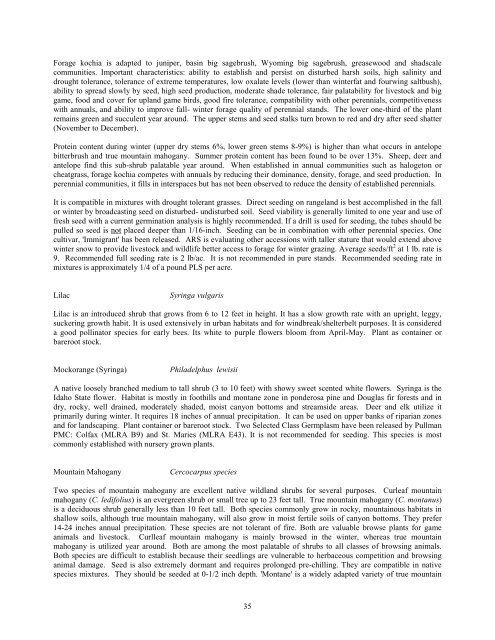Idaho Plant Materials Technical Note No. 24
Idaho Plant Materials Technical Note No. 24
Idaho Plant Materials Technical Note No. 24
You also want an ePaper? Increase the reach of your titles
YUMPU automatically turns print PDFs into web optimized ePapers that Google loves.
Forage kochia is adapted to juniper, basin big sagebrush, Wyoming big sagebrush, greasewood and shadscale<br />
communities. Important characteristics: ability to establish and persist on disturbed harsh soils, high salinity and<br />
drought tolerance, tolerance of extreme temperatures, low oxalate levels (lower than winterfat and fourwing saltbush),<br />
ability to spread slowly by seed, high seed production, moderate shade tolerance, fair palatability for livestock and big<br />
game, food and cover for upland game birds, good fire tolerance, compatibility with other perennials, competitiveness<br />
with annuals, and ability to improve fall- winter forage quality of perennial stands. The lower one-third of the plant<br />
remains green and succulent year around. The upper stems and seed stalks turn brown to red and dry after seed shatter<br />
(<strong>No</strong>vember to December).<br />
Protein content during winter (upper dry stems 6%, lower green stems 8-9%) is higher than what occurs in antelope<br />
bitterbrush and true mountain mahogany. Summer protein content has been found to be over 13%. Sheep, deer and<br />
antelope find this sub-shrub palatable year around. When established in annual communities such as halogeton or<br />
cheatgrass, forage kochia competes with annuals by reducing their dominance, density, forage, and seed production. In<br />
perennial communities, it fills in interspaces but has not been observed to reduce the density of established perennials.<br />
It is compatible in mixtures with drought tolerant grasses. Direct seeding on rangeland is best accomplished in the fall<br />
or winter by broadcasting seed on disturbed- undisturbed soil. Seed viability is generally limited to one year and use of<br />
fresh seed with a current germination analysis is highly recommended. If a drill is used for seeding, the tubes should be<br />
pulled so seed is not placed deeper than 1/16-inch. Seeding can be in combination with other perennial species. One<br />
cultivar, 'Immigrant' has been released. ARS is evaluating other accessions with taller stature that would extend above<br />
winter snow to provide livestock and wildlife better access to forage for winter grazing. Average seeds/ft 2 at 1 lb. rate is<br />
9. Recommended full seeding rate is 2 lb/ac. It is not recommended in pure stands. Recommended seeding rate in<br />
mixtures is approximately 1/4 of a pound PLS per acre.<br />
Lilac<br />
Syringa vulgaris<br />
Lilac is an introduced shrub that grows from 6 to 12 feet in height. It has a slow growth rate with an upright, leggy,<br />
suckering growth habit. It is used extensively in urban habitats and for windbreak/shelterbelt purposes. It is considered<br />
a good pollinator species for early bees. Its white to purple flowers bloom from April-May. <strong>Plant</strong> as container or<br />
bareroot stock.<br />
Mockorange (Syringa)<br />
Philadelphus lewisii<br />
A native loosely branched medium to tall shrub (3 to 10 feet) with showy sweet scented white flowers. Syringa is the<br />
<strong>Idaho</strong> State flower. Habitat is mostly in foothills and montane zone in ponderosa pine and Douglas fir forests and in<br />
dry, rocky, well drained, moderately shaded, moist canyon bottoms and streamside areas. Deer and elk utilize it<br />
primarily during winter. It requires 18 inches of annual precipitation. It can be used on upper banks of riparian zones<br />
and for landscaping. <strong>Plant</strong> container or bareroot stock. Two Selected Class Germplasm have been released by Pullman<br />
PMC: Colfax (MLRA B9) and St. Maries (MLRA E43). It is not recommended for seeding. This species is most<br />
commonly established with nursery grown plants.<br />
Mountain Mahogany<br />
Cercocarpus species<br />
Two species of mountain mahogany are excellent native wildland shrubs for several purposes. Curleaf mountain<br />
mahogany (C. ledifolius) is an evergreen shrub or small tree up to 23 feet tall. True mountain mahogany (C. montanus)<br />
is a deciduous shrub generally less than 10 feet tall. Both species commonly grow in rocky, mountainous habitats in<br />
shallow soils, although true mountain mahogany, will also grow in moist fertile soils of canyon bottoms. They prefer<br />
14-<strong>24</strong> inches annual precipitation. These species are not tolerant of fire. Both are valuable browse plants for game<br />
animals and livestock. Curlleaf mountain mahogany is mainly browsed in the winter, whereas true mountain<br />
mahogany is utilized year around. Both are among the most palatable of shrubs to all classes of browsing animals.<br />
Both species are difficult to establish because their seedlings are vulnerable to herbaceous competition and browsing<br />
animal damage. Seed is also extremely dormant and requires prolonged pre-chilling. They are compatible in native<br />
species mixtures. They should be seeded at 0-1/2 inch depth. 'Montane' is a widely adapted variety of true mountain<br />
35
















